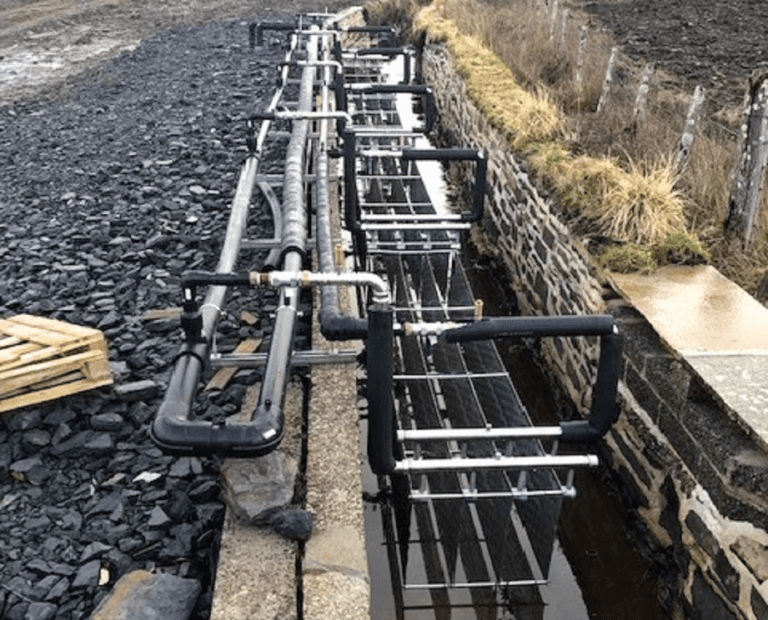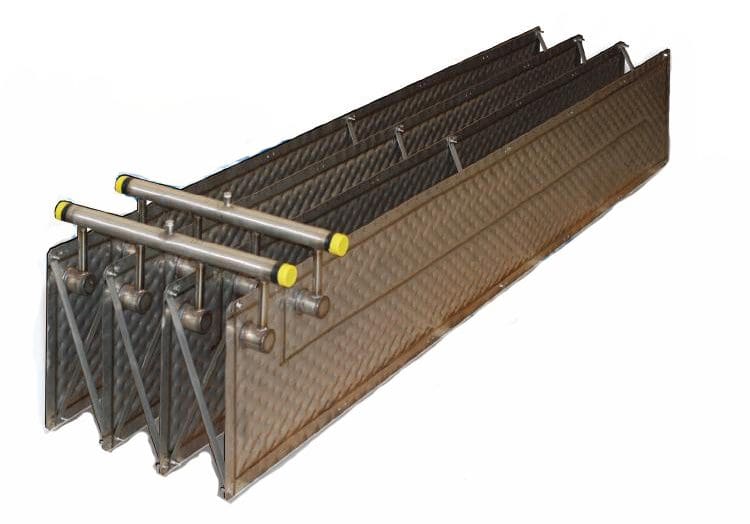
What is an Energy Blade?
The Energy Blade is a water-source heat exchanger for flowing or static water use that extracts heat from water with a ground source heat pump. The innovative design maximises the energy extraction rate from the smallest possible footprint.
It is more effective in fast-flowing water as the energy transfer works similarly to standard plate heat exchangers—the more heat energy that flows past, the more significant the energy transfer.
The heat will transfer if the source water is warmer than the fluid inside the blades. The greater the temperature difference, the faster the heat transfers.
The liquid content in individual blades is 5l. Taking into account the manifolds, the volume of one bank (four blades) is approximately 35l (containing 9l of concentrated glycol). Traditional glycol is a harmful substance, so the glycol used in the energy blade is non-toxic – usually propylene glycols such as Sentinel R500.

The blade is a fresh take on the more traditional coiled MDPE ‘slinky’ collectors which aren’t suitable for flowing water and contain a higher glycol concentration than an equivalent blade array.
Specification
- Stainless steel blades arrive in a pre-assembled bank of four plates with an integral manifold.
- 3000 x 500mm per blade. Four blades measure 3000 x 500 x 800mm.
- Multiple banks of four can be joined to increase capacity.
Design and installation
A bank of four blades operates at a flow rate of 1.2l/s, with a flow-return temperature spread of approximately 3 degrees Celsius . The actual spread is dependant on the capacity of the adjoining heat pump but does not affect the system’s performance dramatically, given that the flow rate doesn’t drop below 0.9l/s. Double flow rates are achieved by connecting the blades in a series.
In standard closed-loop ground collectors, the average ground temperature is typically 9°C, with typical water temperatures around 12°C. Each Energy Blade can produce up to 25kW (taking the heat pump COP as 3.5:1) depending on water flow.
Water flow ranges:
- Stagnant: 100-W/m2/K
- Steady: 200-W/m2/K
- Rapid: 300-W/m2/K
- White water: 400-W/m2/K
Which deliver:
- Stagnant: 8kW
- Steady: 13kW
- Rapid: 20kW
- White water: 25kW
Use of the blade heat exchange configuration simplifies installation, resulting in less environmental disruption. A typical 18kW GSHP system requires up to 1400m of collector pipe installed 1m down and 1m apart, disrupting a significant land area while the energy blade is just 3m x 600mm x 600mm.
Positioning
The plates stand horizontally at the lake, pond, or riverbed, holding the blades vertically and the manifold on top. It’s best to rest the unit on a skid made of a non-corrosive material.
Service requirements
The Energy blade is classed as a closed loop collector system, minimising servicing and maintenance when compared to an open loop collector that requires regular filter servicing.
Versatile integration and scalability
The Nuenta Energy Blade offers versatile integration with various renewable energy systems. It can be seamlessly integrated into new or existing wind energy installations, heat pumps, or solar arrays, providing a scalable solution for increasing energy output. The water-source heat exchanger adapts to different applications, whether incorporated into small-scale residential or large-scale commercial installations.
Environmental benefits and sustainability
The optimised energy output reduces reliance on traditional energy sources, minimising carbon emissions and contributing to a reduction in climate impacts. In addition, as a closed-loop system it doesn’t affect the ecology of the watercourse, making it easier to obtain the necessary permissions from water authorities.
Conclusion
Delivering advanced power conversion and versatile integration, the Nuenta Energy Blade is redefining efficiency, maximising energy output for a more efficient and sustainable future.


